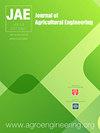3D-printed biological habitats for the protection and persistence of Rhizobia species in compacted soils
IF 2.5
4区 农林科学
Q2 AGRICULTURAL ENGINEERING
引用次数: 0
Abstract
Microorganisms in soils are responsible for many ecosystem services. However, in degraded soils microbial abundance and function are limited which compromises several biologically facilitated processes. Inoculating soils with desirable microbes can help to re-instate or initiate a viable functioning microbial community. However, establishment success is reliant on the survival of the microorganism in an adverse environment. In this proof-of-concept study, artificial microbial refugia have been developed using resin and light-emitting diode array (LED) 3D printing technology. We assessed whether the artificial refugia, termed a Rhiome, would support better microbial growth in degraded soils. Soil compaction, a form of soil degradation, and Rhizobium, an important microorganism for global agriculture, were both selected as the use case application for this assessment. Different materials together with resin were assessed for their suitability as a 3D printing material and for supporting rhizobial growth. The best result was found in materials constructed with a combination of polylactic acid (PLA) resin, yeast extract and mannitol. In a soil compaction experiment with inoculation of rhizobia, the addition of Rhiome significantly increased bacterium survival in the compacted soil to a level similar to, or higher than, the rhizobial loading in non-compacted soils. Augmentation of the resin with yeast extract and mannitol increased Rhizobium growth significantly compared with the Rhiome constructed only with resin. These results indicate that the Rhiome was highly beneficial for instigating and maintaining significant rhizobia survival and growth in compacted soils. Further work, including near-to-field assessments, are required to assess Rhiome performance in a range of applications and to refine material properties relative to important context-specific performance metrics such as degradation rate. We propose the Rhiome concept as a promising asset in the toolbox for soil ecological restoration as a means of improving soil resiliency.3d打印生物栖息地的保护和根瘤菌物种在压实土壤的持久性
土壤中的微生物负责许多生态系统服务。然而,在退化的土壤中,微生物的丰度和功能是有限的,这损害了几个生物促进过程。用所需的微生物接种土壤可以帮助恢复或启动一个可行的功能微生物群落。然而,建立成功依赖于微生物在不利环境中的生存。在这项概念验证研究中,利用树脂和发光二极管阵列(LED) 3D打印技术开发了人工微生物避难所。我们评估了人工避难所,称为根茎,是否会支持退化土壤中更好的微生物生长。土壤压实(土壤退化的一种形式)和根瘤菌(全球农业的重要微生物)都被选为该评估的用例应用。不同的材料与树脂一起评估了它们作为3D打印材料的适用性和支持根瘤菌生长的能力。以聚乳酸(PLA)树脂、酵母浸膏和甘露醇为复合材料的制备效果最好。在接种根瘤菌的土壤压实试验中,添加根瘤菌显著提高了压实土壤中细菌的存活率,使其达到或高于未压实土壤中根瘤菌负荷的水平。与仅用树脂构建根茎相比,用酵母提取物和甘露醇增强树脂可显著提高根瘤菌的生长。这些结果表明,根茎对促进和维持根瘤菌在压实土壤中的生存和生长非常有益。需要进一步的工作,包括近场评估,以评估Rhiome在一系列应用中的性能,并根据重要的特定环境性能指标(如降解率)改进材料性能。我们提出根茎概念作为土壤生态恢复工具箱中的一个有前途的资产,作为提高土壤弹性的一种手段。
本文章由计算机程序翻译,如有差异,请以英文原文为准。
求助全文
约1分钟内获得全文
求助全文
来源期刊

Journal of Agricultural Engineering
AGRICULTURAL ENGINEERING-
CiteScore
2.30
自引率
5.60%
发文量
40
审稿时长
10 weeks
期刊介绍:
The Journal of Agricultural Engineering (JAE) is the official journal of the Italian Society of Agricultural Engineering supported by University of Bologna, Italy. The subject matter covers a complete and interdisciplinary range of research in engineering for agriculture and biosystems.
 求助内容:
求助内容: 应助结果提醒方式:
应助结果提醒方式:


